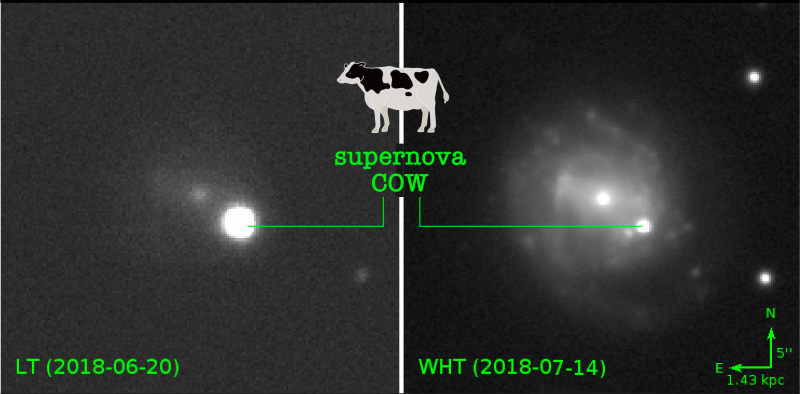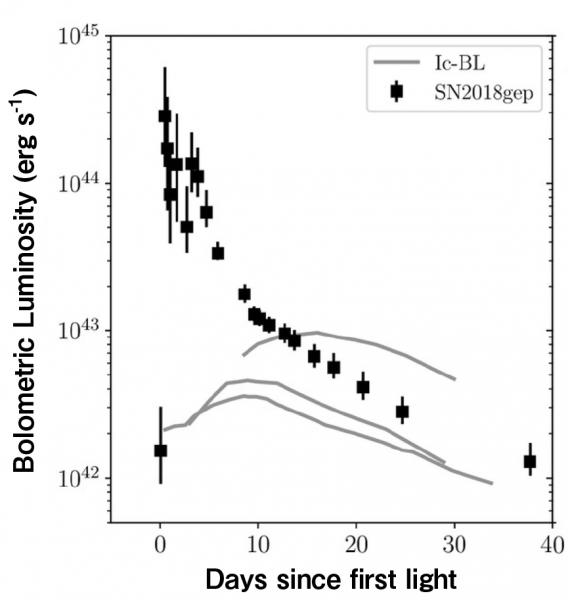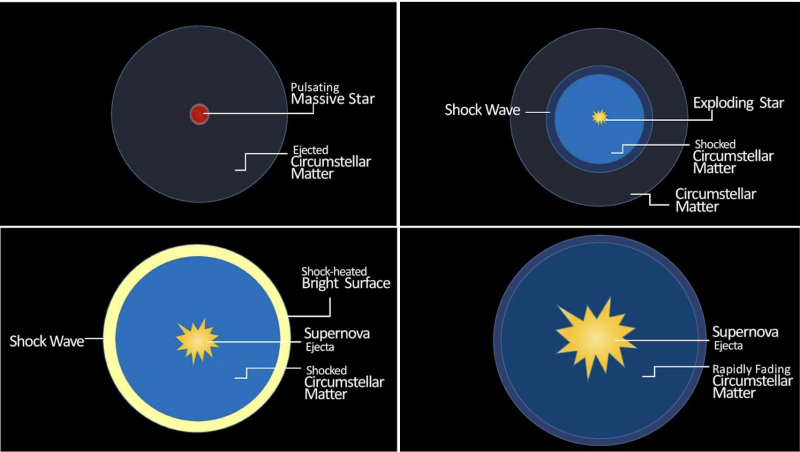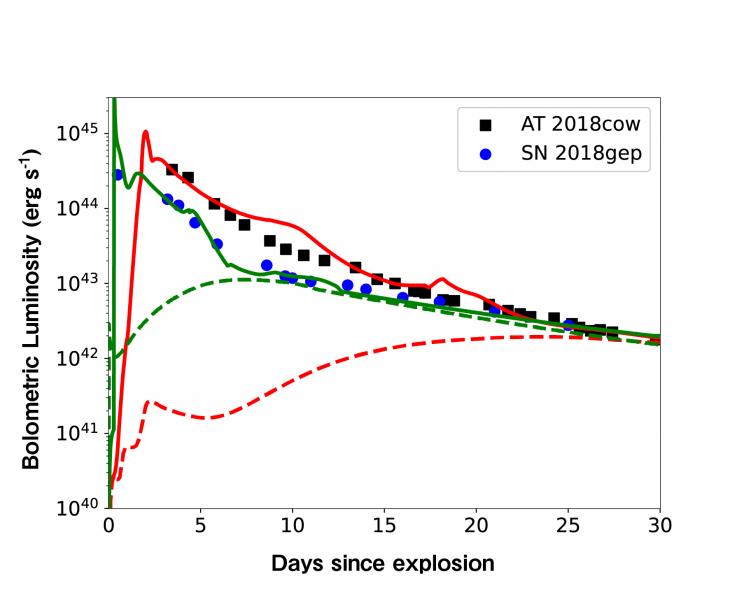January 18, 2022
Kavli Institute for the Physics and Mathematics of the Universe (Kavli IPMU)

Appearing ten to a hundred times brighter at its peak, and with a much faster rise toward the peak, stellar explosions AT 2018cow (nicknamed the COW) and SN 2018gep (nicknamed the GEP) represent a new type of supernova called Fast Blue Optical Transient (FBOT), reports two recent studies.
Thanks to recent extensive supernova observations by several telescopes worldwide, COW and GEP appeared in the night sky in 2018 and were well-observed from the early phase of their explosions (figure 1). But their origin was a mystery.
To find a theoretical model, Shing-Chi Leung, a former Kavli Institute for the Physics and Mathematics of the Universe (Kavli IPMU) Project Researcher (currently a postdoctoral scholar at the California Institute of Technology), and Kavli IPMU Senior Scientist Ken’ichi Nomoto, organized two international teams of researchers to study each explosion, and have now succeeded in explaining COW and GEP features.

Observational data showed the COW had the brightest peak and the shortest rising time (about 1 day) among FBOTs. The GEP had a slightly lower brightness and a longer rising time (about 3 days), compared to the COW (figure 2).
Both research groups then successfully modeled the light curve, uncovering a clear picture of a possible sequence of events in both explosions (figure 3).
First, the star would have ejected its surface materials just before the explosion. These ejected materials would have formed a dense and opaque circumstellar matter (CSM) around the star, making the radius of the star much larger than ordinary presupernova stars. Such a presupernova mass ejection mechanism might have been caused by the pulsational pair-instability of very massive stars, which Leung and Nomoto had previously seen while studying the origin of massive black holes (see the related article).
When the supernova explosion occurred in the star, a strong shock wave would have formed and propagated through the CSM. When it reached the CSM surface, its kinetic energy would have converted into thermal and radiation energy, causing a sudden and a very bright event to occur, which is consistent with the very fast rise of the observed brightness of the supernova.
The CSM surface became as bright as observed peak of COW because of the large "radius", but once CSM quickly lost most of its energy and faded, it became transparent, giving way to an ordinary supernova light.

The theoretical supernova light curves powered by the shock-heating of the CSM the researchers created were found to be in good agreement with the observational data of the COW and the GEP, respectively (figure 4).

The researchers also found that without CSM, the rising of the light curve was much slower and the maximum luminosity was much lower, indicating FBOTs can be linked to CSM-heating.
The research teams are now proposing that the variation the CSM mass formed from the pulsational pair-instability of very massive stars would cause variation among FBOTs. If the CSM mass is large enough, the resulting supernova would be observed as a so-called Superluminous Supernova which is bright but shows much slower rising.
The next step is to confirm this hypothesis with more observations.
The results of both studies were published online in The Astrophysical Journal on 3 November 2020 [1] and 8 July 2021 [2].
Paper details
Paper [1]
Journal: The Astrophysical Journal
Paper title: A Model for the Fast Blue Optical Transient AT2018cow: Circumstellar Interaction of a Pulsational Pair-instability Supernova
Authors: Shing-Chi Leung (2,1), Sergei Blinnikov (1,3,4), Ken'ichi Nomoto (1), Petr Blakanov (3,5,6), Elena Sorokina (3,7) and Alexey Tolstov (8,1)
Author affiliations
1 Kavli Institute for the Physics and Mathematics of the Universe (WPI), The University of Tokyo Institutes for Advanced Study, The University of Tokyo, Kashiwa,
Chiba 277-8583, Japan;
2 TAPIR, Walter Burke Institute for Theoretical Physics, Mailcode 350-17, Caltech, Pasadena, CA 91125, USA
3 National Research Center “Kurchatov institute,” Institute for Theoretical and Experimental Physics (ITEP), 117218 Moscow, Russia
4 Dukhov Automatics Research Institute (VNIIA), Suschevskaya 22, 127055 Moscow, Russia
5 National Research Nuclear University MEPhI, Kashirskoe sh. 31, Moscow 115409, Russia
6 Space Research Institute (IKI), Russian Academy of Sciences, Profsoyuznaya 84/32, 117997 Moscow, Russia
7 Sternberg Astronomical Institute, M.V. Lomonosov Moscow State University, Universitetski pr. 13, 119234 Moscow, Russia
8 The Open University of Japan, 2-11, Wakaba, Mihama-ku, Chiba, Chiba 261-8586, Japan
DOI: 10.3847/1538-4357/abba33 (published 3 November, 2020)
Paper abstract (The Astrophysical Journal)
Preprint (arXiv.org)
Paper [2]
Journal: The Astrophysical Journal
Paper title: Fast Blue Optical Transients Due to Circumstellar Interaction and the Mysterious
Supernova SN 2018gep
Authors: Shing-Chi Leung (1), Jim Fuller (1), Ken’ichi Nomoto (2)
Author affiliations:
1 TAPIR, Walter Burke Institute for Theoretical Physics, Mailcode 350-17,
Caltech, Pasadena, CA 91125, USA
2 Kavli Institute for the Physics and Mathematics of the Universe (WPI),
The University of Tokyo Institutes for Advanced Study, The University of
Tokyo, Kashiwa, Chiba 277-8583, Japan
DOI: 10.3847/1538-4357/abfcbe (published 8 July, 2021)
Paper abstract (The Astrophysical Journal)
Preprint (arXiv.org)
Research contact
Ken'ichi Nomoto
Senior Scientist
Kavli Institute for the Physics and Mathematics of the Universe (Kavli IPMU), The University of Tokyo
E-mail: nomoto_at_astron.s.u-tokyo.ac.jp
*Please change _at_ to @
Media contact
Motoko Kakubayashi
Press officer
Kavli Institute for the Physics and Mathematics of the Universe (Kavli IPMU), The University of Tokyo
E-mail: press_at_ipmu.jp
*Please change _at_ to @
Related article
Researchers find the origin and the maximum mass of massive black holes observed by gravitational wave detectors.






